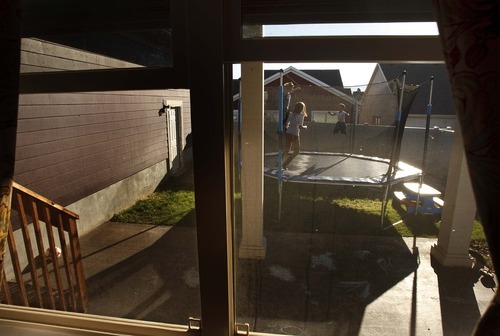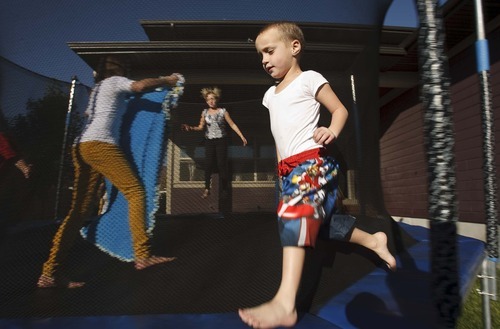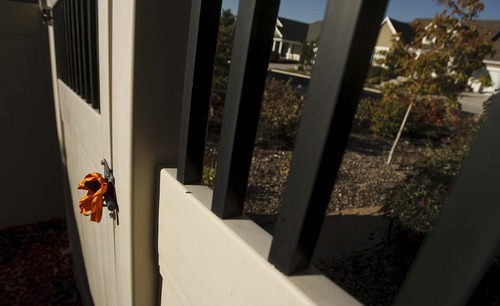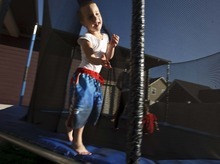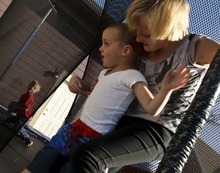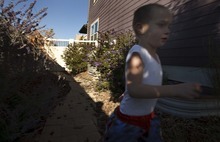This is an archived article that was published on sltrib.com in 2012, and information in the article may be outdated. It is provided only for personal research purposes and may not be reprinted.
Cobilynn Dickinson lives with fear every day.
Her son has autism, and he's a runner who doesn't always respond to his name. So the South Jordan mother bolts the door as soon as the family enters the house, or she has a sibling stand guard when she's unloading groceries. She recently installed an alarm system to alert her when doors are opened.
"For the last three years, I haven't left his side," she says of her 4-year-old, Hagen. "When he gets out, he just runs. … He can be anywhere and he won't answer you."
He's been found safe so far, but the hazards are there: He ignored the ditch and busy road to once hide in a car. "That's the fear that we live with everyday," she said — that he will get hit by a car, drown or simply disappear.
A new study published Monday in the journal Pediatrics shows such behavior is a common, and dangerous, problem: In an online survey of parents of 1,200 children with autism, half said their child had attempted to wander off after age 4, when most children have outgrown the typical-toddler behavior. Wandering, or elopement, was defined as the child leaving a supervised, safe space or the care of a responsible person.
Autism spectrum disorders are characterized by a lack of communication and social skills. The disorder means children don't realize they should let their parents know where they're going, and it makes it difficult for them to return after they wander, says Utah pediatrician Paul Carbone, who treats children with autism and has a 9-year-old son on the spectrum.
He co-edited a new American Academy of Pediatrics' book, "Autism Spectrum Disorders: What Every Parent Needs to Know," which includes information on wandering. "There's some potentially disastrous consequences to it," he said.
And it's not because the parents are neglectful: The study showed siblings who didn't have the disorder were less likely to elope.
—
Unafraid, but in danger • Utah parents whose children have an autism spectrum disorder say they have several locks on doors in their homes, including the room of their autistic child. They've found their children blocks away in stranger's houses, or near busy streets. Police often get involved.
"All of us have had our children run away at some point," said Mirella Petersen, president of the Utah Autism Coalition.
She said her now 5-year-old son Jaden used to hide in unfinished homes being built in their neighborhood. He got past her lock-up devices and was once found at 5 a.m. delivering water to kids' homes, giving each their favorite color of cup.
She credits two years of behavioral therapy, learning about boundaries and safety, with getting him to stop.
Monday's study shows such therapy can help, but it called for further research on interventions. It found that children who eloped had more severe autism, with lower intellectual and communication skills. They commonly left their home, stores or schools.
Among the children who wandered, 1 in 4 were missing long enough to cause concern. Many families lose sleep or give up activities outside the home because of the behaviors, according to the study.
And while the children who ran away did so because they enjoyed running or exploring, or were trying to avoid a situation that made them anxious, many could have been seriously hurt. Of those who went missing, a quarter could have drowned and more than half could have been injured in traffic.
Police were called about one-third of the time, according to the study. It was conducted by the Interactive Autism Network at Kennedy Krieger Institute in Maryland.
Kendria Adams called the police when her daughter disappeared at age 4. Julia didn't know her parents' names, phone number or address and didn't respond to people. She was found down the street at a stranger's house. She had walked inside, gone upstairs and started playing.
"Julia didn't seem to be bothered by it one bit," said Adams, of Centerville. "That's what's hard about it. If another typical child was lost they would be distraught. They would start crying."
The study showed the found children were often content.
—
Tips: Signs, swimming lessons • While the study showed the wandering attempts peaked at age 5, Adams said it remains a concern. Julia wore a medical ID bracelet until age 13. Now 17, the teen is a rule-keeper and doesn't wander on her own. Still, "nobody can answer the door when Julia's home and we're not," Adams said. She fears her daughter would leave with whoever was there.
Adams recommends parents pass out fliers to neighbors to alert them what to do if they see their wandering child — that's what helped them find Julia that winter.
"Knowing your neighbors and your community can be a huge benefit to the well-being of your family and your peace of mind," she said.
Carbone advises parents to do the same, along with locking doors and windows and putting up small stop signs to prompt the wanderers to stay home. He also suggests fencing the yard, putting them in swimming lessons to help them stay safe if they do escape and using wearable identification. Many children with autism may not like to wear IDs they can feel, so there are tags for shoes and pant loops and even codes that can be ironed on clothes.
Lt. Mark Lowther, with the Weber County Sheriff's Office, also suggests parents inform police that they have a child with autism. He helps train officers around the state about autism, in part because they will likely be called in to help with searches. He tells them to examine bodies of water first and offers tips, such as letting a family member approach the child once he or she is found.
Dickinson enrolled her son in the Carmen B. Pingree Center for Children with Autism, where he's learning to stay close by holding hands, to walk when he's outside and to stop.
"It's just a matter of time and constant teaching for him to understand what we mean," she said. —
New guide for parents
Paul Carbone knows about autism as a pediatrician and as a parent.
The Utah doctor has a son on the autism spectrum disorder. And he treats children with autism. Now, he's co-edited a book, "Autism Spectrum Disorders: What Every Parent Needs to Know," which is published by the American Academy of Pediatrics.
A resource guide for caregivers of children with autism, its 15 chapters covers the gamut, including defining the disorder, warning signs of autism, therapies and alternative medicine.
The book also gives a shout-out to Utahn Carmen Pingree, the advocate whose name graces the Salt Lake City elementary school for children with autism.
In an interview, Carbone said he didn't want the book to paint a false picture of autism — that every child hits and every couple gets divorced. While some children, whose autism is severe and who have other intellectual disabilities, may always be dependent, other children with autism thrive, he said.
"We wrote this book with the idea that it would deliver a very hopeful message," he said. "We think the newest generation of children with autism really face a better future than past generations."
With proper support, he said, "The sky can be the limit for these kids."
Heather May —
To learn more
For resources on preventing wandering, go to nationalautismassociation.org







